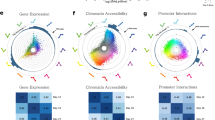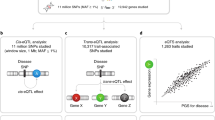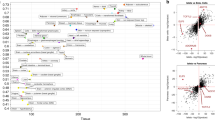Abstract
Genome-wide association studies have identified many genetic variants associated with complex traits. However, at only a minority of loci have the molecular mechanisms mediating these associations been characterized. In parallel, whereas cis regulatory patterns of gene expression have been extensively explored, the identification of trans regulatory effects in humans has attracted less attention. Here we show that the type 2 diabetes and high-density lipoprotein cholesterol–associated cis-acting expression quantitative trait locus (eQTL) of the maternally expressed transcription factor KLF14 acts as a master trans regulator of adipose gene expression. Expression levels of genes regulated by this trans-eQTL are highly correlated with concurrently measured metabolic traits, and a subset of the trans-regulated genes harbor variants directly associated with metabolic phenotypes. This trans-eQTL network provides a mechanistic understanding of the effect of the KLF14 locus on metabolic disease risk and offers a potential model for other complex traits.
This is a preview of subscription content, access via your institution
Access options
Subscribe to this journal
Receive 12 print issues and online access
$209.00 per year
only $17.42 per issue
Buy this article
- Purchase on Springer Link
- Instant access to full article PDF
Prices may be subject to local taxes which are calculated during checkout


Similar content being viewed by others
Accession codes
Change history
22 September 2011
In the version of this article initially published, there were several errors in the P values reported in the Adiponectin and HOMA-IR columns of Table 3. These errors have been corrected in the HTML and PDF versions of the article.
References
Voight, B.F. et al. Twelve type 2 diabetes susceptibility loci identified through large-scale association analysis. Nat. Genet. 42, 579–589 (2010).
Teslovich, T.M. et al. Biological, clinical and population relevance of 95 loci for blood lipids. Nature 466, 707–713 (2010).
Kong, A. et al. Parental origin of sequence variants associated with complex diseases. Nature 462, 868–874 (2009).
Nica, A.C. et al. The architecture of gene regulatory variation across multiple human tissues: the MuTHER study. PLoS Genet. 7, e1002003 (2011).
Emilsson, V. et al. Genetics of gene expression and its effect on disease. Nature 452, 423–428 (2008).
Dang, D.T., Pevsner, J. & Yang, V.W. The biology of the mammalian Kruppel-like family of transcription factors. Int. J. Biochem. Cell Biol. 32, 1103–1121 (2000).
Zambelli, F., Pesole, G. & Pavesi, G. Pscan: finding over-represented transcription factor binding site motifs in sequences from co-regulated or co-expressed genes. Nucleic Acids Res. 37, W247–W252 (2009).
Portales-Casamar, E. et al. JASPAR 2010: the greatly expanded open-access database of transcription factor binding profiles. Nucleic Acids Res. 38, D105–D110 (2010).
Kaczynski, J., Cook, T. & Urrutia, R. Sp1- and Kruppel-like transcription factors. Genome Biol. 4, 206 (2003).
McConnell, B.B. & Yang, V.W. Mammalian Kruppel-like factors in health and diseases. Physiol. Rev. 90, 1337–1381 (2010).
Dupuis, J. et al. New genetic loci implicated in fasting glucose homeostasis and their impact on type 2 diabetes risk. Nat. Genet. 42, 105–116 (2010).
Heid, I.M. et al. Meta-analysis identifies 13 new loci associated with waist-hip ratio and reveals sexual dimorphism in the genetic basis of fat distribution. Nat. Genet. 42, 949–960 (2010).
Speliotes, E.K. et al. Association analyses of 249,796 individuals reveal 18 new loci associated with body mass index. Nat. Genet. 42, 937–948 (2010).
Spector, T.D. & Williams, F.M. The UK Adult Twin Registry (TwinsUK). Twin Res. Hum. Genet. 9, 899–906 (2006).
Skidmore, P.M. et al. Relation of birth weight, body mass index, and change in size from birth to adulthood to insulin resistance in a female twin cohort. J. Clin. Endocrinol. Metab. 93, 516–520 (2008).
Aulchenko, Y.S. et al. Loci influencing lipid levels and coronary heart disease risk in 16 European population cohorts. Nat. Genet. 41, 47–55 (2009).
Richards, J.B., Valdes, A.M., Burling, K., Perks, U.C. & Spector, T.D. Serum adiponectin and bone mineral density in women. J. Clin. Endocrinol. Metab. 92, 1517–1523 (2007).
Prokopenko, I. et al. Variants in MTNR1B influence fasting glucose levels. Nat. Genet. 41, 77–81 (2009).
Falchi, M., Wilson, S.G., Paximadas, D., Swaminathan, R. & Spector, T.D. Quantitative linkage analysis for pancreatic B-cell function and insulin resistance in a large twin cohort. Diabetes 57, 1120–1124 (2008).
Li, H., Ruan, J. & Durbin, R. Mapping short DNA sequencing reads and calling variants using mapping quality scores. Genome Res. 18, 1851–1858 (2008).
Aulchenko, Y.S., Ripke, S., Isaacs, A. & van Duijn, C.M. GenABEL: an R library for genome-wide association analysis. Bioinformatics 23, 1294–1296 (2007).
Aulchenko, Y.S., Struchalin, M.V. & van Duijn, C.M. ProbABEL package for genome-wide association analysis of imputed data. BMC Bioinformatics 11, 134 (2010).
Barrett, T. et al. NCBI GEO: archive for functional genomics data sets–10 years on. Nucleic Acids Res. 39, D1005–D1010 (2011).
Visscher, P.M., Benyamin, B. & White, I. The use of linear mixed models to estimate variance components from data on twin pairs by maximum likelihood. Twin Res. 7, 670–674 (2004).
de Bakker, P.I. et al. Efficiency and power in genetic association studies. Nat. Genet. 37, 1217–1223 (2005).
Teo, Y.Y. et al. A genotype calling algorithm for the Illumina BeadArray platform. Bioinformatics 23, 2741–2746 (2007).
Howie, B.N., Donnelly, P. & Marchini, J. A flexible and accurate genotype imputation method for the next generation of genome-wide association studies. PLoS Genet. 5, e1000529 (2009).
Acknowledgements
The MuTHER study was funded by the Wellcome Trust Program grant # 081917. Genotyping of TwinsUK samples was provided by the Wellcome Trust Sanger Institute and the National Eye Institute via a US National Institutes of Health (NIH)/Center for Inherited Disease Research (CIDR) genotyping project. TwinsUK also receives support from the ENGAGE project grant agreement HEALTH-F4-2007-201413 and from the Department of Health via the National Institute for Health Research (NIHR) comprehensive Biomedical Research Centre award to Guy's & St. Thomas' National Health Service Foundation Trust in partnership with King's College London. T.D.S. is an NIHR senior investigator and European Research Council (ERC) senior investigator. M.I.M. is supported by the Oxford NIHR Biomedical Research Centre. Additional support was provided by the Louis-Jeantet Foundation to E.T.D. and A.C.N. and via NIH-NIMH grant R01 MH090941 to E.T.D. and M.I.M.
Author information
Authors and Affiliations
Consortia
Contributions
K.S.S., Å.K.H., E.G., G.T. and A.C.N. analyzed data. G.T., A.K., S.-Y.S., H.B.R., N.S. and C.M.L. contributed reagents, materials and analysis tools. U.T., K.R.A., K.S., E.T.D., P.D., M.I.M. and T.D.S. conceived and designed the experiments. K.S.S. and M.I.M. wrote the paper with contributions from Å.K.H. and E.G. All authors read and approved the manuscript before submission.
Corresponding author
Ethics declarations
Competing interests
The author declare no competing financial interests.
Additional information
A full list of members is provided in the Supplementary Note.
A full list of members is provided in the Supplementary Note.
A full list of members is provided in the Supplementary Note.
A full list of members is provided in the Supplementary Note.
Supplementary information
Supplementary Text and Figures
Supplementary Figures 1 and 2, Supplementary Table 1 and Supplementary Note. (PDF 612 kb)
Rights and permissions
About this article
Cite this article
the MuTHER Consortium. Identification of an imprinted master trans regulator at the KLF14 locus related to multiple metabolic phenotypes. Nat Genet 43, 561–564 (2011). https://doi.org/10.1038/ng.833
Received:
Accepted:
Published:
Issue Date:
DOI: https://doi.org/10.1038/ng.833
This article is cited by
-
The KLF14 Variant is Associated with Type 2 Diabetes and HbA1C Level
Biochemical Genetics (2021)
-
Dissecting features of epigenetic variants underlying cardiometabolic risk using full-resolution epigenome profiling in regulatory elements
Nature Communications (2019)
-
Dissecting an adiposity locus with an arsenal of genomics
Genome Biology (2018)
-
Epigenetics Variation and Pathogenesis in Diabetes
Current Diabetes Reports (2018)



